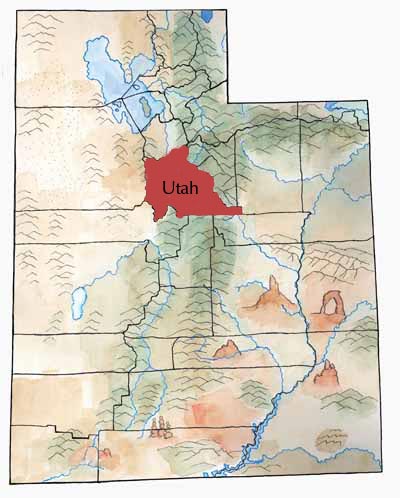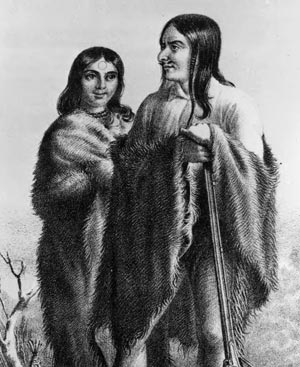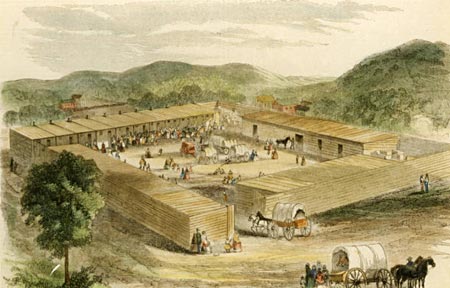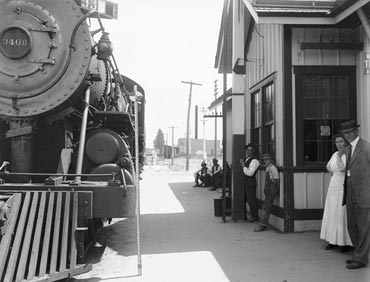The most striking geographical features of Utah County are the Wasatch Mountains along the eastern boundary and Utah Lake, the state’s largest fresh-water lake, to the west. The high mountains, rising over 11,000 feet, receive heavy snowfall, which feeds the rivers and creeks that flow into the lake.

Utah Lake is a remnant of the vast ancient Lake Bonneville. Though large in size, Utah Lake is very shallow—18 feet at its deepest point.
The grassy Utah Valley became farmlands after settlement. Now the farmlands are gradually being developed into subdivisions and commercial areas.
First Peoples
Utah County’s mountains, lake, streams, and valleys have sustained humans since at least 10,000 BC. Utah Lake was once a rich fishery, and people lived and camped on its shores.

The lifeways and culture of humans developed over time. Archaeologists call the people living during the Ice Age as Paleoindians. The Archaic culture followed the Paleoindian culture.
In 1991, archaeologists excavated the remains of an Archaic-period man on the shore of Utah Lake. The man had been buried with tools, basketry, and a dog.
The next prehistoric culture is called the Fremont culture. Fremont Indians lived here until about 1200 AD, farming corn, squash, and beans. They also fished, hunted, and gathered plant foods.
By 1800, three historical Native American tribes used Utah Valley: Paiutes, who used the west side of Utah Lake; Shoshones, who sometimes traveled here from north; and the Utes, who were the main group who lived around the lake.
History
The Dominguez-Escalante expedition passed through Utah Valley in 1776. The Timpanogots Utes in the valley welcomed the padres and helped them.
Fur trappers stopped at the lake in the 1820s. Etienne Provost was one of them—and Provo was named after him. John C. Fremont visited the area in 1844.
Settlers

A party of Mormons explored the valley in 1847. In January 1849 Brigham Young sent a fishing party to catch fish for the hungry settlers in Salt Lake Valley. That same year, other settlers moved to Utah Valley and established a fort at the present site of Provo.
The Utes who lived in the valley resented the pioneers taking their land. Violent conflicts arose, but no matter how hard they fought for their land, the Utes couldn’t win. They lost their land and had to move to the reservation in the Uinta Basin.
Economy
The settlers farmed, growing crops, fruit, and sugar beets. Orem was once full of orchards. Today, developers have taken out the orchards and built roads, commercial centers, and subdivisions.
Utah County has fostered important industries. The Provo Woolen Mill became the state’s first large manufacturing plant in 1873.
In the late 1800s and early 1900s mines in American Fork Canyon and in the Tintic Mining District produced much wealth.

During World War II, the United States needed a lot of steel to build ships, airplanes, and more. Geneva Steel was built on the east shore of Utah Lake during this time. The government chose this location because they thought that steel plants closer to the coast could be destroyed by the country’s enemies.
Geneva Steel employed many people in the county for many years. In 2001 it closed. The buildings were demolished.
Brigham Young University, established in 1875 as the Brigham Young Academy, has grown to be a major university. BYU and Utah Valley University have an important influence on the county.
Did You Know?
| John Koyle had a dream he would find gold east of Salem; many people lost lots of money investing in his Dream Mine. |
| Utah Lake was once teeming with fish that fed the Utes—and also helped Mormon settlers from starving. |
| There was once a German prisoner of war camp in Orem. The prisoners worked in local orchards and farms. |
| JB’s Big Boy got its start in Provo, and was also the first fast food place in Utah County. |
| BYU graduates started successful computer-related companies like WordPerfect and Novell Inc. |
Fast Facts
Area: 2,014 Square Miles
County Seat: Provo
Where it Got its Name: Local tradition about Ute language
Main Cities and Towns: Provo, Orem, American Fork, Springville, Pleasant Grove, Spanish Fork
Economy
Keep Exploring!
Return to the County’s home page here.
Return to the I Love Utah History home page here.